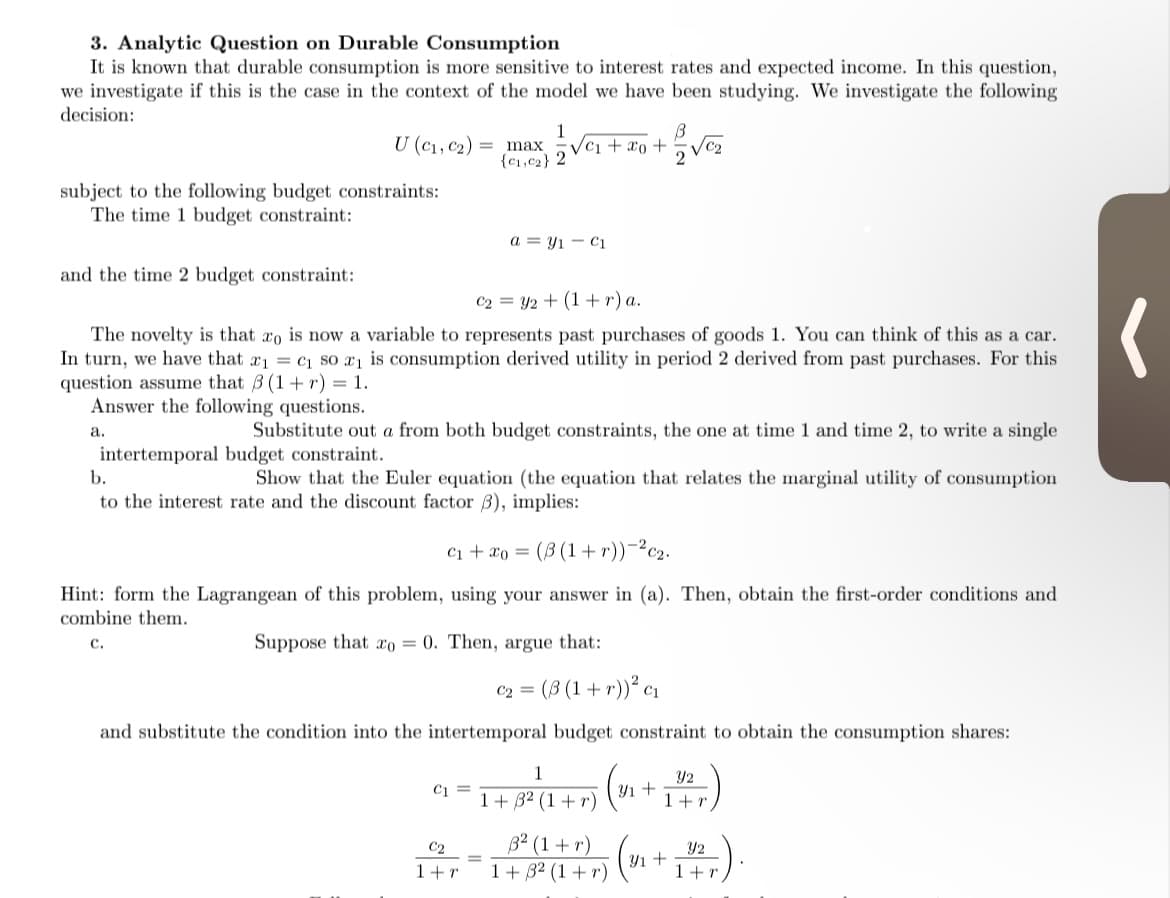3. Analytic Question on Durable Consumption It is known that durable consumption is more sensitive to interest rates and expected income. In this question, ve investigate if this is the case in the context of the model we have been studying. We investigate the following lecision: 1 U (c1, c2) = max {c1,c2} 2 /C1 + o+ ubject to the following budget constraints: The time 1 budget constraint: a = Y1 - C nd the time 2 budget constraint: C2 = Y2 + (1 +r) a. The novelty is that ro is now a variable to represents past purchases of goods 1. You can think of this as a car. n turn, we have that a1 = c1 so a1 is consumption derived utility in period 2 derived from past purchases. For this juestion assume that B (1+r) = 1. Answer the following questions. а. Substitute out a from both budget constraints, the one at time 1 and time 2, to write a single
3. Analytic Question on Durable Consumption It is known that durable consumption is more sensitive to interest rates and expected income. In this question, ve investigate if this is the case in the context of the model we have been studying. We investigate the following lecision: 1 U (c1, c2) = max {c1,c2} 2 /C1 + o+ ubject to the following budget constraints: The time 1 budget constraint: a = Y1 - C nd the time 2 budget constraint: C2 = Y2 + (1 +r) a. The novelty is that ro is now a variable to represents past purchases of goods 1. You can think of this as a car. n turn, we have that a1 = c1 so a1 is consumption derived utility in period 2 derived from past purchases. For this juestion assume that B (1+r) = 1. Answer the following questions. а. Substitute out a from both budget constraints, the one at time 1 and time 2, to write a single
Chapter1: Making Economics Decisions
Section: Chapter Questions
Problem 1QTC
Related questions
Question

Transcribed Image Text:3. Analytic Question on Durable Consumption
It is known that durable consumption is more sensitive to interest rates and expected income. In this question,
we investigate if this is the case in the context of the model we have been studying. We investigate the following
decision:
U (c1, c2)
1
max
{c1,c2} 2
VCi + xo +
subject to the following budget constraints:
The time 1 budget constraint:
a = Y1 - Ci
and the time 2 budget constraint:
C2 = Y2 + (1 +r) a.
The novelty is that ro is now a variable to represents past purchases of goods 1. You can think of this as a car.
In turn, we have that x1 = c1 so a1 is consumption derived utility in period 2 derived from past purchases. For this
question assume that B (1+ r) = 1.
Answer the following questions.
а.
Substitute out a from both budget constraints, the one at time 1 and time 2, to write a single
intertemporal budget constraint.
b.
Show that the Euler equation (the equation that relates the marginal utility of consumption
to the interest rate and the discount factor 3), implies:
C1 + xo = (B (1 +r))-²c2.
Hint: form the Lagrangean of this problem, using your answer in (a). Then, obtain the first-order conditions and
combine them.
с.
Suppose that xo = 0. Then, argue that:
C2 = (B (1 + r))² c1
C1
and substitute the condition into the intertemporal budget constraint to obtain the consumption shares:
1
Y2
Y1 +
C1 =
1+ 32 (1 + r)
1+r
B2 (1+ r)
1 + 32 (1 + r)
Y2
Yı +
C2
1+r
1+r
Expert Solution
This question has been solved!
Explore an expertly crafted, step-by-step solution for a thorough understanding of key concepts.
This is a popular solution!
Trending now
This is a popular solution!
Step by step
Solved in 2 steps

Knowledge Booster
Learn more about
Need a deep-dive on the concept behind this application? Look no further. Learn more about this topic, economics and related others by exploring similar questions and additional content below.Recommended textbooks for you


Principles of Economics (12th Edition)
Economics
ISBN:
9780134078779
Author:
Karl E. Case, Ray C. Fair, Sharon E. Oster
Publisher:
PEARSON

Engineering Economy (17th Edition)
Economics
ISBN:
9780134870069
Author:
William G. Sullivan, Elin M. Wicks, C. Patrick Koelling
Publisher:
PEARSON


Principles of Economics (12th Edition)
Economics
ISBN:
9780134078779
Author:
Karl E. Case, Ray C. Fair, Sharon E. Oster
Publisher:
PEARSON

Engineering Economy (17th Edition)
Economics
ISBN:
9780134870069
Author:
William G. Sullivan, Elin M. Wicks, C. Patrick Koelling
Publisher:
PEARSON

Principles of Economics (MindTap Course List)
Economics
ISBN:
9781305585126
Author:
N. Gregory Mankiw
Publisher:
Cengage Learning

Managerial Economics: A Problem Solving Approach
Economics
ISBN:
9781337106665
Author:
Luke M. Froeb, Brian T. McCann, Michael R. Ward, Mike Shor
Publisher:
Cengage Learning

Managerial Economics & Business Strategy (Mcgraw-…
Economics
ISBN:
9781259290619
Author:
Michael Baye, Jeff Prince
Publisher:
McGraw-Hill Education